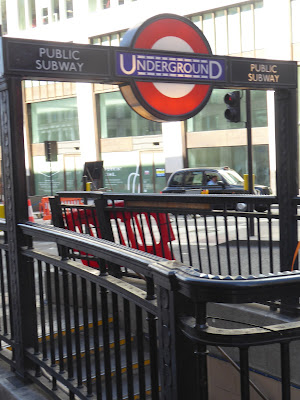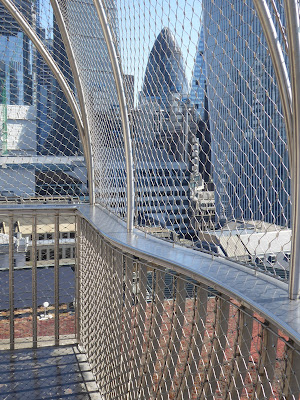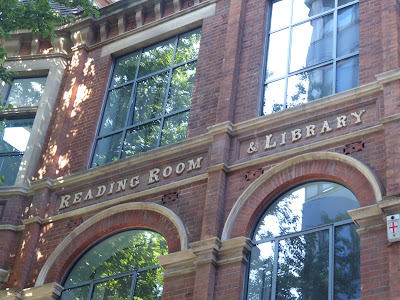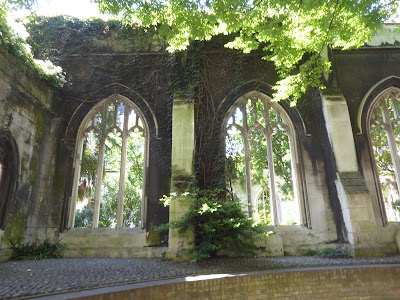This is the 17th station on the Circle Line that I have visited for my 'Above the Underground' project. This is a map of the area and as you can see there are four underground station in close proximity to one another. So the walk around Monument Station follows on from my walk for the previous post on Cannon Street.
Monument station is on the Circle and District Lines and is linked to the Central and Northern Lines via a long tunnel to Bank station. The roundel is supported by a pair of dragons. This is in reference to the City of London coat of arms where the crest of the City is supported by a dragon on either side.
These art deco pillars can be found in the ticket hall.
The two main entrances into the tube station.

I exited the station on King William St. at the junction with Cannon St. There are four subway exits here which help you to exit on the road you want without having to negotiate the traffic.
The eagle eyed owl sits atop the clock of House of Fraser department store looking along King William Street to London Bridge.
Just before you cross London Bridge you see the Fishmonger's Hall or as it is commonly called, fish hall on the right hand side.
It is one of the most ancient of the City Guilds and is one of the Great Twelve Livery Companies. It was completely destroyed in the Great Fire and rebuilt twice after that but bombed during WW2. After the war it was restored to its former glory. Immediately after the Great Fire the new hall was one of the first important riverside buildings completed in the City.That building survived for 150 years and was painted by many artists including Canaletto. The fishmongers of London were an organised community long before they were granted a Royal Charter in 1272. but the charter gave them complete monopoly over the sale of fish in London. Fish being a food necessity during the Middle Ages the Company became very wealthy. The Company even had its own court of Law to settle disputes over fish. Today the Company supports a number of fish and fisheries related organisations as well as a range of charities.

The first bridge over the Thames was built here. London Bridge has been rebuilt many times since then. The medieval bridge c1200 had narrow picturesque houses built on it but they were removed when it was widened in 1758-62. The bridge that was here from 1823 can now be found crossing Lake Havasu in Arizona USA where it has been since 1971. This present bridge built in 1968-72 has nothing to distinguish it as a great structure.

I walked round the corner onto Monument St where there is a blue plaque marking the site of the abandoned King William Street tube station. It opened in 1890 as the first deep tunnel underground station but closed in 1900 through lack of use. It was last opened during WW2 and used as an air raid shelter. Apparently the station still exists beneath the office block.
It is from Monument St that you get the best view of the Monument which was designed by Robert Hooke in consultation with Sir Christopher Wren and was built 1671-77. It was constructed to commemorate the Great Fire of London in 1666. The fire burnt from 2nd to 5th September devastating two thirds of the City. It destroyed 13,200 houses, 87 churches and 52 Livery Company halls.

Looking at the top of the monument you can see the cage built around the balcony to prevent people jumping off.
The allegorical relief on the pedestal shows the figure of Charles II coming to assist the slumped figure of the City of London.
I decided I had to go up the Monument just to get a view from the top for my readers. It is many years since I have climbed up the spiral staircase. There are no lifts, just the one staircase with 311 steps up and 311 steps down! There is just enough room to make way for people coming down but only just.
As we are in the middle of a heatwave at the moment the view was a bit hazy but you can still make out the landmarks. This is a view of Tower Bridge and the City hall on the right hand side.
It was known to be the best place to commit suicide until they covered the walkway with wire netting.
You can just about see the towers of The Tower of London with Docklands in the distance.
Roof top gardens everywhere.
Clear view of St Paul's Cathedral.
The walkie talkie building with the cheesegrater building on the left and more new buildings going up.
On these concrete seats near the entrance to the Monument you can read the nursery rhyme 'London's Burning'.
London's Burning, London's Burning.
Fetch the engines, fetch the engines.
Fire! Fire! Fire! Fire!
Pour on water, pour on water.
The 61m Monument stands 61m from where the fire started in Pudding Lane.
There is a plaque on the corner of the lane showing where it started.

Fish St Hill to the South of the Monument leads to St Magnus the Martyr, a Wren church, alongside which is the ancient street which led to the medieval London Bridge.
I continued down Lower Thames Street passing Custom House.

There has been a Custom House on or near this site for over 2000 years. It is thought that this is the fifth Custom House to have been built on the site since Roman times.

The present building dates from 1813-17 and overlooks the River Thames. The captain of every ship that came up the Thames had to come here. Until he paid his Custom duties he would not be allowed to unload or sell his cargo. The ships would arrive filled with goods such as cloth or spices and would stay until they had sold their goods and loaded new cargo. Records show that at times there were 400 ships moored outside Custom House. The cargo of every ship was weighed, measured and examined to determine how much duty was owed. Once the duty was paid, a release certificate was provided which allowed the captain to sell his cargo. .Forging the certificates was punishable by death.

It was only when container shipping became too large to travel this far up the Thames in the 1960s and 70s that this activity ended. The London docks went into decline with the trade moving gradually down river.

Next to Custom House is the old Billingsgate Fish Market. Since Roman times there has been a fish market on this site until 1982 when the market moved to new premises on the Isle of Dogs.
The weathervanes are the only reminder of its past.
Lovat Lane gives us an idea of the width of the lanes within the city. Here you can see the church of St Mary at Hill towering above the other buildings.
I walked to the end of Lovat lane which brought me out onto Eastcheap.
This grade II Victorian listed building at 33-35 Eastcheap, stands out for its Neo Gothic style dwarfed by the modern skyscrapers. There used to be a pub here called the Boar's Head Tavern and was used a s meeting place in a number of Shakespeare's plays. The tavern was burnt down in the Great Fire. The current building dates from 1868 and was constructed for use a s a vinegar warehouse depot. Today the upper floors are used as offices whilst downstairs on the ground floor is a branch of Black Sheep Coffee.
I walked back down St Mary at Hill and saw the other side of the church with its clock overhanging the pavement. This is another of Wren's churches built after the Great Fire costing £3,890 to rebuild.
Further on down the hill is The Watermen's Hall
Watermen's Hall is home to the company of Watermen and Lightermen of the River Thames. From ancient times the Thames has been the main thoroughfare for carrying people and goods. Before the Romans built a bridge across the river, the wherries were the only way to cross. Watermen carry passengers whilst Lightermen carry goods and cargo. in 1514 the earliest Act of Parliament for regulating watermen, wherrymen and bargemen received its Royal Assent from King Henry VIII. In 1700 the lightermen joined the company. Nowadays the Guild facilitates an apprentice scheme. There are over 390 Craft owning Freemen and also 500 journeymen Freemen who have completed a five yearapprenticeship to become qualified Watermen and/or Lightermen9 now the Boat Master's Licence).
This impressive building on the corner of Lower Thames Street and St Mary at Hill was once a Christian Mission for the workers of Billingsgate market. It offered many facilities and later became a library and reading room. It currently seems to have been converted into apartments.
The next lane I walked up was St Dunstan's to visit the remains of thethe church St Dunstan's in the East.
The church of St Dunstan was originally built around 1100 .g. It was severely damaged in the Great Fire and rather than being completely rebuilt it was patched up with a new tower and steeple added by Sir Christopher Wren in 1695-1701.Unfortunately the church was severely damaged in the Blitz of 1941. Wren's tower and steeple survived but it was decided not to rebuild the church.In 1967 the City of London decided to turn the remains intos a public garden. It opened in 1970 and is my favourite City garden.
On my walk back to the station I went past the walkie talkie building on Fenchurch Street.
The top floors of the building curve over and provide an interesting public space known as the Sky Garden .


You get a great view of London from the top floor with a pleasant small garden to wander around. It is free to visit but you have to book in advance online.

Monument station is on the Circle and District Lines and is linked to the Central and Northern Lines via a long tunnel to Bank station. The roundel is supported by a pair of dragons. This is in reference to the City of London coat of arms where the crest of the City is supported by a dragon on either side.
These art deco pillars can be found in the ticket hall.
The two main entrances into the tube station.

I exited the station on King William St. at the junction with Cannon St. There are four subway exits here which help you to exit on the road you want without having to negotiate the traffic.
The eagle eyed owl sits atop the clock of House of Fraser department store looking along King William Street to London Bridge.
Just before you cross London Bridge you see the Fishmonger's Hall or as it is commonly called, fish hall on the right hand side.
It is one of the most ancient of the City Guilds and is one of the Great Twelve Livery Companies. It was completely destroyed in the Great Fire and rebuilt twice after that but bombed during WW2. After the war it was restored to its former glory. Immediately after the Great Fire the new hall was one of the first important riverside buildings completed in the City.That building survived for 150 years and was painted by many artists including Canaletto. The fishmongers of London were an organised community long before they were granted a Royal Charter in 1272. but the charter gave them complete monopoly over the sale of fish in London. Fish being a food necessity during the Middle Ages the Company became very wealthy. The Company even had its own court of Law to settle disputes over fish. Today the Company supports a number of fish and fisheries related organisations as well as a range of charities.


The first bridge over the Thames was built here. London Bridge has been rebuilt many times since then. The medieval bridge c1200 had narrow picturesque houses built on it but they were removed when it was widened in 1758-62. The bridge that was here from 1823 can now be found crossing Lake Havasu in Arizona USA where it has been since 1971. This present bridge built in 1968-72 has nothing to distinguish it as a great structure.

It is from Monument St that you get the best view of the Monument which was designed by Robert Hooke in consultation with Sir Christopher Wren and was built 1671-77. It was constructed to commemorate the Great Fire of London in 1666. The fire burnt from 2nd to 5th September devastating two thirds of the City. It destroyed 13,200 houses, 87 churches and 52 Livery Company halls.

Looking at the top of the monument you can see the cage built around the balcony to prevent people jumping off.
The allegorical relief on the pedestal shows the figure of Charles II coming to assist the slumped figure of the City of London.
I decided I had to go up the Monument just to get a view from the top for my readers. It is many years since I have climbed up the spiral staircase. There are no lifts, just the one staircase with 311 steps up and 311 steps down! There is just enough room to make way for people coming down but only just.
As we are in the middle of a heatwave at the moment the view was a bit hazy but you can still make out the landmarks. This is a view of Tower Bridge and the City hall on the right hand side.
It was known to be the best place to commit suicide until they covered the walkway with wire netting.
You can just about see the towers of The Tower of London with Docklands in the distance.
Roof top gardens everywhere.
Clear view of St Paul's Cathedral.
The walkie talkie building with the cheesegrater building on the left and more new buildings going up.
On these concrete seats near the entrance to the Monument you can read the nursery rhyme 'London's Burning'.
London's Burning, London's Burning.
Fetch the engines, fetch the engines.
Fire! Fire! Fire! Fire!
Pour on water, pour on water.
The 61m Monument stands 61m from where the fire started in Pudding Lane.
There is a plaque on the corner of the lane showing where it started.

Fish St Hill to the South of the Monument leads to St Magnus the Martyr, a Wren church, alongside which is the ancient street which led to the medieval London Bridge.
I continued down Lower Thames Street passing Custom House.

There has been a Custom House on or near this site for over 2000 years. It is thought that this is the fifth Custom House to have been built on the site since Roman times.

The present building dates from 1813-17 and overlooks the River Thames. The captain of every ship that came up the Thames had to come here. Until he paid his Custom duties he would not be allowed to unload or sell his cargo. The ships would arrive filled with goods such as cloth or spices and would stay until they had sold their goods and loaded new cargo. Records show that at times there were 400 ships moored outside Custom House. The cargo of every ship was weighed, measured and examined to determine how much duty was owed. Once the duty was paid, a release certificate was provided which allowed the captain to sell his cargo. .Forging the certificates was punishable by death.

It was only when container shipping became too large to travel this far up the Thames in the 1960s and 70s that this activity ended. The London docks went into decline with the trade moving gradually down river.

The building is now used by HM Revenue and Customs. I visited during Open House weekend and was entertained with a number of interesting tales of how and where custom officers discovered smuggled goods coming into the country.
Cigarettes hidden in this pile of composite wood.
Next to Custom House is the old Billingsgate Fish Market. Since Roman times there has been a fish market on this site until 1982 when the market moved to new premises on the Isle of Dogs.
The weathervanes are the only reminder of its past.
Riverside view of the old Billingsgate Market which is now used as an entertainment venue.
Just across the road from Custom House is Lovat Lane. On the corner with Lower Thames Street is the pub The Walrus and the Carpenter. The pub is named after a poem written by Lewis Carrol who is most famous for writing 'Alice in Wonderland'
Lovat Lane gives us an idea of the width of the lanes within the city. Here you can see the church of St Mary at Hill towering above the other buildings.
I walked to the end of Lovat lane which brought me out onto Eastcheap.
This grade II Victorian listed building at 33-35 Eastcheap, stands out for its Neo Gothic style dwarfed by the modern skyscrapers. There used to be a pub here called the Boar's Head Tavern and was used a s meeting place in a number of Shakespeare's plays. The tavern was burnt down in the Great Fire. The current building dates from 1868 and was constructed for use a s a vinegar warehouse depot. Today the upper floors are used as offices whilst downstairs on the ground floor is a branch of Black Sheep Coffee.

I walked back down St Mary at Hill and saw the other side of the church with its clock overhanging the pavement. This is another of Wren's churches built after the Great Fire costing £3,890 to rebuild.
Further on down the hill is The Watermen's Hall
This impressive building on the corner of Lower Thames Street and St Mary at Hill was once a Christian Mission for the workers of Billingsgate market. It offered many facilities and later became a library and reading room. It currently seems to have been converted into apartments.
The next lane I walked up was St Dunstan's to visit the remains of thethe church St Dunstan's in the East.
The church of St Dunstan was originally built around 1100 .g. It was severely damaged in the Great Fire and rather than being completely rebuilt it was patched up with a new tower and steeple added by Sir Christopher Wren in 1695-1701.Unfortunately the church was severely damaged in the Blitz of 1941. Wren's tower and steeple survived but it was decided not to rebuild the church.In 1967 the City of London decided to turn the remains intos a public garden. It opened in 1970 and is my favourite City garden.
On my walk back to the station I went past the walkie talkie building on Fenchurch Street.
The top floors of the building curve over and provide an interesting public space known as the Sky Garden .


You get a great view of London from the top floor with a pleasant small garden to wander around. It is free to visit but you have to book in advance online.

From the windows you have a good view of the Tower of London which will feature on the next tube station I will be visiting.


























































You snapped the hat trick with the walkie talkie building, no only including the cheesegrater but the gherkin too. The plaque at Walrus and the Carpenter is very reflective. I think the Eastcheap building is extremely interesting. 61 metres seemed an odd figure for the monument, until I converted it to 200 feet. Another fine stroll with you in London.
ReplyDeleteInteresting area - my hubby knows it quite well - he works in Custom House. It's such a mix of old and new. Your knees must be in better shape than mine though - I wouldn't be climbing the Monument lol
ReplyDeleteThis station and sites around it are familiar to me. Thanks for the views from the top of the monument -- I have never made it to the top! I visited the Customs House on Open House day the last time I was in London. What an excellent overview of the Tower on London.
ReplyDeleteLoved this and I plan to come back for a more careful read of the last half, but I didn’t want to forget to bow in awe that you climbed 311 steps and back in the middle of a heat wave! Thank you for sharing the views and info! Tthe part about the fisheries history was fascinating, never thought about what a major necessity fish would have been.
ReplyDeleteAnother fascinating tour of architecture. Thanks!
ReplyDeleteI was in the area recently - but didn't explore as much as you did. Lovely shots.
ReplyDeleteMust be nice to live so close to London, you get to enjoy its beauty frequently.
ReplyDeleteWorth a Thousand Words
The spiral staircase is beautiful from afar … reminding me of circling shells I’ve seen. The wall of plants is something that’s catching on. Our local library has one and it’s a delight to see.
ReplyDeleteIt does look very hot and sunny for that walk. It seems you are having considerably higher temperatures than up here on the cool coast. I wonder if there is anyone around who doesn't know the story of the the Great Fire and Pudding Lane. Go and put your feet up now, you deserve it after that marathon.
ReplyDeleteVery interesting descriptions thanks. The views from up high were especially great so thanks for climbing all those stairs! The garden at St Dunstans in lovely.
ReplyDeleteAmazing! So much beauty.
ReplyDeleteWonderful post, gives us an idea of the breadth and depth of London history.
ReplyDeleteHello, wonderful tour and photos. So much to see, I love all the details. The owl on the clock, the monument, the windows and weathervane. Beautiful views of the city. Happy Wednesday, enjoy your day! PS, thanks for visiting my blog.
ReplyDeleteI love the house of fraser building, can you do a post on the history of it?
ReplyDelete